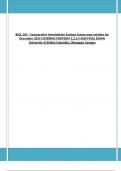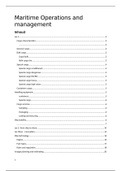BIOL 205 - Comparative Invertebrate Zoology (exam prep solution for
December 2024 COVERING MIDTERM 1,2,3,4 AND FINAL EXAM)
University of British Columbia, Okanagan Campus
,Porifera Classes - Calcarea, Hexactinellida, Demospongiae, Homoscleromorpha
Placozoa - No neurons, no muscles, similar to planular larva, similar to porifera,
do asexual reproduction
Pinacocytes - protective cells, make up the outer layer or poriferans, called the
pinacoderm
Mesohyl - Gelatinous layer of spongin, spicules, and archaeocytes
Archaeocytes - Also called amoebocytes, specialized cells that perform digestion,
distribute nutrients, and engulf foreign matter. Specialized archaeocytes called
sclerocytes produce spicules
Spicules - Provide structural support to sponge, can be calcareous or silicious
Choanocytes - Also called collar cells, contain flagella that beat to generate water
flow through the sponge. Similar to choanoflagellates
Body forms of Porifera - Asconoid, Syconoid, and Leuconoid
,Gemmules - Internal buds seen in some freshwater Porifera. Do asexual
reproduction by remaining in a dormant state until after winter
Cnidaria Classes - Hydrozoa, Scyphozoa, Anthozoa, Cubozoa, Staurozoa
Cnidocytes - Stinging cells, contain a nematocyst coiled inside, discharged by the
cnidocil being triggered and water rushes into the cell
Polyp - Sessile Cnidaria form, usually reproduce asexually
Medusa - Motile form of Cnidaria, usually reproduce sexually
Mesoglea - gelatinous layer in between cellular layers (Epidermis and
Gastrodermis) of Cnidaria. Not a cellular layer, but contains cells.
Gastrovascular cavity - Incomplete digestive tract, only one hole for the
mouth/anus. Food is digested and absorbed through the gastrodermis, which
lines the cavity
Cnidaria life cycle - Sperm/Egg fertilization -> Planula -> Scyphistoma -> Strobila ->
Ephyra -> Genet
Strobilation - Division of adult polyp (Strobila) into ramets, buds that will develop
into Ephyra (larval form of medusa)
, Class Hydrozoa - Form colonies that are connected by gastrovascular cavities,
includes Hydra, Hydrocorals (not true corals, includes fire corals), and Physalia
(Portuguese man-or-war)
Class Anthozoa - No medusa stage, solitary or colonial, all marine. Includes Order
Actinaria (Anemones) and order Scleractinia (True corals)
Ctenophora - Biradial symmetry, paired tentacles, diploblastic, bands of cilia that
beat to generate movement, bioluminescence, monocecious, Colloblasts (glue
cells) for catching prey, gelatinous collenchyme layer in between cellular layers
Phylum Acoela/Acoelomorpha/ Xenocoelomorpha - Bilateral symmetry,
incomplete digestive tract, false gastrovascular cavity (not lined by gastrodermis),
monoecious, hermaphroditic, sexual reproduction, radial nerve system
Platyhelminthes Classes - Turbellaria, Trematoda, Monogenea, Cestoda
Protonephridia - System of tubules with blind entrances for filtrate, contain flame
bulbs/cells that do filtration. Wastes exit through openings called nephridopores
Phylum Platyhelminthes - Early cephalization, bilateral symmetry, acoelomate,
mouth near the middle of the body (Planaria), auricles (ears), ocelli (eye spots),
and tactile/chemosensory structures on head





